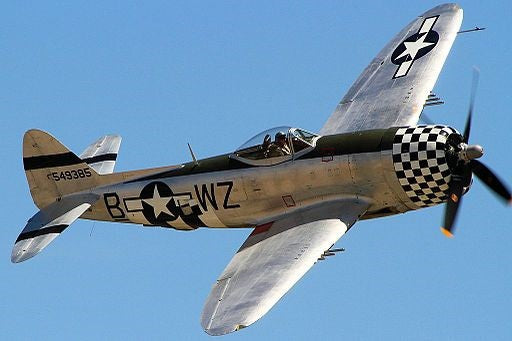When the pages of World War II aviation history are turned, the P-47 Thunderbolt emerges as a true juggernaut, its formidable presence dominating the skies. This remarkable fighter aircraft, renowned for its size, power, and durability, played a pivotal role in the Allied victory, leaving an indelible mark on the era.
The Birth of a Giant
The P-47 Thunderbolt’s journey to the skies was fueled by the vision of Alexander Kartveli, its chief designer, who dreamt of creating a fighter aircraft that could match and surpass the enemy’s capabilities. What transpired was a machine that was not only immense but also packed a powerful punch; with its Pratt & Whitney R-2800 Double Wasp engine — one Among the ranks of the mightiest piston engines ever created, this model stands tall.
A Force to Be Reckoned With
The Thunderbolt, affectionately dubbed the “Jug” due to its jug-like shape, was a force to be reckoned with. With its sturdy structure and potent engine, the P-47 Thunderbolt could haul a staggering array of weapons and plenty of fuel, making it perfect for guarding bombers and striking targets on the ground. Its arsenal of eight .50 caliber machine guns turned it into a fearsome opponent in dogfights, and its capacity to carry bombs and rockets meant it packed a serious punch against ground forces as well.
Mastering the Art of Combat
Pilots of the P-47 Thunderbolt had to master the art of flying this giant, using its unique characteristics to their advantage. The aircraft’s turbo-supercharger allowed it to maintain power at high altitudes, while its rugged design could withstand significant damage, allowing pilots to push the aircraft to its limits. These features, combined with its lethal firepower, made the Thunderbolt an essential component of the Allied air forces.
A Legacy of Valor and Versatility
The P-47 Thunderbolt’s contribution to World War II went beyond its capabilities in combat. The P-47 Thunderbolt was indispensable in dominating the skies, keeping our bombers safe, and offering priceless assistance to the troops fighting below. Its remarkable versatility and effectiveness across various missions underscored the critical role of air power in contemporary military strategies.
Conclusion: The Thunderbolt’s Enduring Legacy
The P-47 Thunderbolt has undoubtedly etched its place in history, not just as a brilliant showcase of the engineering excellence and technological advancements of its time but also as a lasting emblem of the bravery and skill of the pilots who masterfully navigated it through the skies. The Thunderbolt’s formidable presence and dominance in the World War II skies serve as a compelling testament to the indispensable role of air power in shaping historical events, firmly establishing the P-47 as a dominant force of its era.
For more insights into the P-47 Thunderbolt. and other important military aircraft, visit Aces In Action. Here, you’ll find an amazing piece of artwork by Craig Tinder titled “Blitz Week,” which illustrates the P-47D Thunderbolt 42-22459 of the 78th Fighter Group during Little Blitz Week, a turning point in the air war over Europe. The limited edition canvas print even includes a piece of an actual fragment of P-47D 42-22459, which crashed in the Ardennes Forest in 1944, making it a unique piece of history!
Blitz Week – P-47D Thunderbolt Aviation Art by Artist Craig Tinder
30 July 1943 – P-47D-2-RA (Serial No. 42-22459) of the 78th Fighter Group, piloted by George Hartman, provides bomber escort on the mission to Kassel, Germany, to attack the Focke-Wulf factory. Outnumbered by 3-to-1, the 78th FG encountered over 100 German fighters attacking the bomber formations. Seven P-47s were lost this day to the Luftwaffe’s loss of 16 aircraft. This period marked the end of “Blitz Week”, the beginning of the Combined Bomber Offensive that initiated the continual aerial bombardment that stretched into Fortress Europe to strike targets at the heart of Germany.
To purchase or see similar items, visit here.
Commissioned by Museums, Treasured by Collectors





Share:
The Evolution of C-130 Hercules: From Conception to Innovation
P-51 Mustang: From WWII Hero to Korean War Veteran